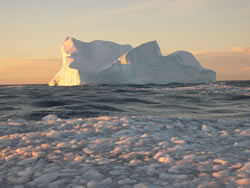Benefits
Developing a comprehensive understanding of the marine biogeochemical cycles of TEIs, and of the processes and conditions that regulate these cycles will bring many benefits that can be shared across a spectrum of ocean disciplines. This section will briefly highlight a few areas where such benefits will be found. For a more detailed account please see the GEOTRACES science plan.
The role of micronutrients in the ocean ecosystem

It has been recognised that micronutrients play a key role in the biogeochemical processes in the ocean; however, our understanding of the roles and cycles of such micronutrients is still rudimentary.
At present the majority of work in this field has concentrated on Fe and it is now well established that the supply of Fe limits total productivity in high-nutrient, low chlorophyll (HNLC) regions of the surface ocean (Coale et al., 1996). From laboratory and limited ocean-surface studies, other trace metals are also believed to play an important part in biogeochemical processes, particularly Cu, Zn, Co, Cd and Mn (Morel et al., 2003; Morel and Price, 2003). Micronutrient dynamics play a crucial role throughout the world’s oceans, fundamentally influencing the type and extent of productivity which in turns governs a whole host of systems and processes. Such processes include the utilisation and cycling of major elements including C and N. A major aim of GEOTRACES it to measure key micronutrient concentrations in all the major ocean basins and subsequently use this data in models to improve our present day understanding.
Transport and fate of contaminants
The oceanic cycles of many TEIs has been significantly impacted by human activity (e.g. lead, mercury). Some of these TEIs are harmful to the natural and human environment due to their toxicity and/or radioactivity. Therefore, understanding the processes that control the transport and fate of such TEIs is an important aspect of protecting the marine environment and human health. Understanding TEIs cycles will provide valuable information on important issues such as
- disposal of waste at sea (e.g acid mine drainage)
- incorporation into the human food chain, where TEIs disposal at sea has already occurred
GEOTRACES will also provide a baseline of TEIs in the reasonably pristine environment of deep water, against which future changes can be assessed.
Tracers of present and past conditions
The ocean has the capacity to store and transport large amounts of heat and carbon making it a prime driver in the climate system. To understand Earth’s climate system, knowledge of the dynamics of the ocean (eg circulation and carbon cycles) is required. Some processes in the ocean can not be directly measured (eg long term rate of deep water flow, long term mixing rates, downward flux of organic carbon) and require the use of TEI tracers ( radiocarbon, 234Th). A better understanding of TEI tracers and their biogeochemical cycles will improve their use and allow them to be applied more robustly to assess the carbon cycle in the past, present and future.
TEI traces can also be used to construct past conditions which is crucial in assessing possible amplitude of future climate changes by the calibration of models using chemical traces of the past ocean environment. A wide variety of geochemical traces have been proposed and calibrated against environmental conditions, these proxies potentially allow reconstruction of past changes of a wide variety of ocean variables. Calibrating such proxies, understanding their strengths and weaknesses, and establishing new proxies represents a primary aim of GEOTRACES.
